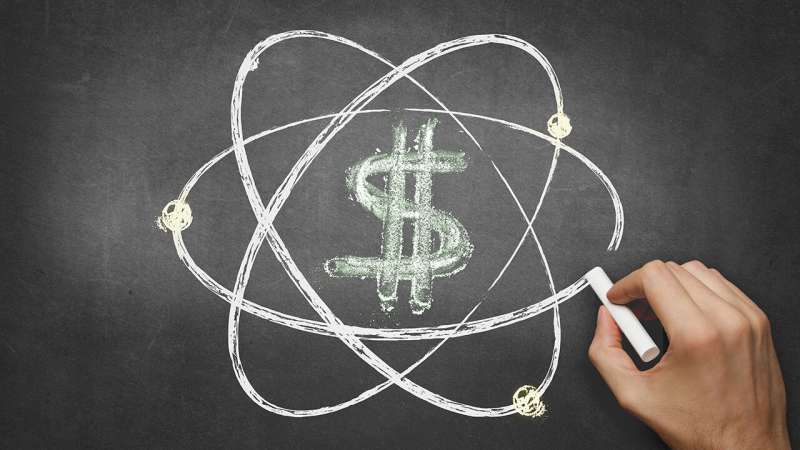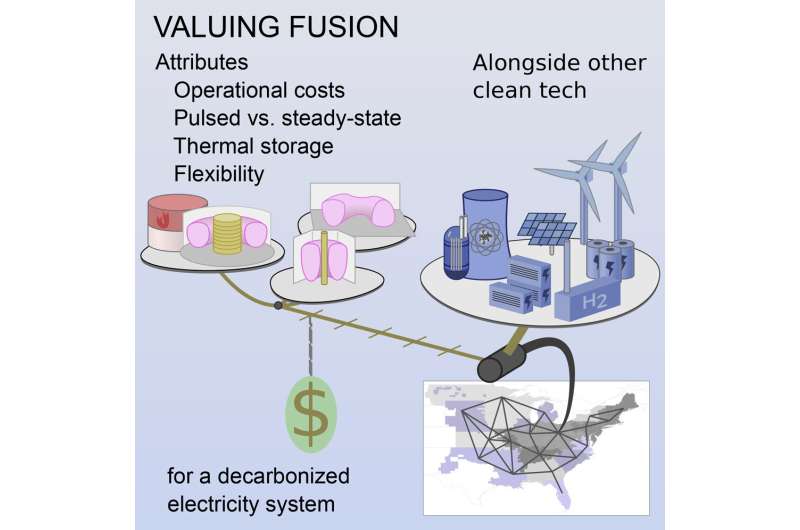This article has been reviewed according to Science X's editorial process and policies. Editors have highlighted the following attributes while ensuring the content's credibility:
fact-checked
peer-reviewed publication
trusted source
proofread
Fusion's future in the US could come down to dollars and cents

Fusion energy is often hailed as a limitless source of clean energy, but new research from Princeton University suggests that may only be true if the price is right.
In a study led by fusion expert Egemen Kolemen, associate professor of mechanical and aerospace engineering and the Andlinger Center for Energy and the Environment, and energy systems expert Jesse Jenkins, assistant professor of mechanical and aerospace engineering and the Andlinger Center for Energy and the Environment, Princeton researchers modeled the cost targets that a fusion reactor might have to meet to gain traction in a future U.S. energy grid.
The findings, published in Joule on Mar. 16, illustrated that the engineering challenges of fusion energy are only part of the problem—the other part lies in economics.
"People will not pay an unlimited amount of money for fusion energy if they could spend that money to generate clean energy more cost-effectively," said Jacob Schwartz, a former postdoc with Kolemen and Jenkins who led the modeling for the study and currently works as a research physicist at the Princeton Plasma Physics Laboratory. "Above a certain cost, even if we can engineer them, not many developers will want to build them."
The model results demonstrated that the niche for fusion in the U.S. depends not only on the price of building a reactor but hinges greatly on the energy mix of the future grid and the cost of competing technologies like nuclear fission.
If the market for fusion is favorable, then even with capital costs as high as around $7,000 per kilowatt, fusion could still reach 100 GW capacity—about the current capacity of U.S. nuclear power plants, which supply about a fifth of today's electricity needs. But supposing alternative technologies like nuclear fission, hydrogen, carbon capture and storage, or long-duration battery storage successfully take root, capital costs might have to be less than half that price for fusion to reach the same 100 GW capacity.
"Fusion developers need to keep an eye on the competition," Jenkins explained. "If successfully commercialized, fusion power plants are likely to look a lot like classic nuclear fission plants from the perspective of electricity markets and grids. Both resources are complex technologies with tight engineering margins for safety reasons, which translates to high upfront investment costs. If the variable costs of fusion power plants end up low, fusion plants will likely compete head-to-head with new fission power plants."
Fusion's place in a renewables-heavy grid
Kolemen explained that the researchers' approach helped establish concrete goals for prospective fusion developers to use as benchmarks when considering plans for reactors.
"Many fusion startups are popping up, all with different reactor designs, saying they can build a reactor with this or that amount of money. But it's almost impossible to assign dollar amounts to individual reactor components," Kolemen said. "So instead, we considered a future grid model with more renewables like wind and solar and worked backward to understand the cost targets that fusion reactors might have to meet to have a place in that future grid mix."
By determining the cost targets for fusion reactors in a grid likely to be dominated by renewable electricity sources like solar and wind, the researchers also gained insight that could inform the design of future fusion reactors.

For example, Schwartz said fusion energy has traditionally been seen as a "baseload" energy source that would operate almost continuously. With widespread solar adoption and subsequently cheap midday electricity prices, however, the research suggests it would be valuable to add functionality to a fusion reactor to enable it to toggle on and off more frequently or to consider ways to store the energy from the reactor and sell it when it is most needed. The researchers said integrating storage into the design of a fusion reactor could increase its value by up to $1000 per kilowatt.
"Capturing more economic value by coupling thermal storage and operating flexibly means the first fusion power plants can compete with higher initial costs," said Jenkins. "That higher 'go-to-market' price point could be key to kickstart the fusion industry and help lower costs over time through experience and incremental innovation."
The model also suggested that the most promising locations for fusion energy in the U.S. would be in the northeastern region, where local solar and wind opportunities are more limited than in other areas.
"The northeast doesn't have the same potential for geothermal or hydropower energy as the western U.S. does, so it's the place where something besides solar and wind will be most needed," said Wilson Ricks, a study co-author and graduate student in mechanical and aerospace engineering.
Exploring the pulsed vs. steady-state debate
In addition to considering fusion energy in the context of a future energy grid, the model also returned initial results that the researchers said could help settle an important question in the fusion research community between the viability of steady-state versus pulsed fusion reactors.
Steady-state and pulsed represent two different design approaches to fusion reactors. A steady-state fusion reactor would operate like a traditional power plant, running almost full-time. A pulsed fusion reactor, on the other hand, would be required to shut down for a short time and then restart every hour or every few hours.
While some scientists have questioned whether the operating requirements for pulsed reactors would make them difficult to integrate with the rest of the energy grid, the model results suggested no significant difference between the two designs regarding their effects on the large-scale grid.
"There's been somewhat of a design battle between the two technologies, so it was interesting that our initial findings suggest there wasn't much of a difference in how they would operate with the rest of the grid," Kolemen said. "From the viewpoint of the model, the best design is simply the cheapest one."
The researchers are following up their findings with additional research on the different costs and opportunities for steady-state and pulsed reactors, as well as how maintenance and upkeep costs could also play a role in the penetration of fusion energy in the U.S. market.
"This research doesn't claim to know when fusion will come online. Fusion reactors may still be decades away from having a large impact on the energy grid. What this research gives us is a clear target for fusion researchers and startups to aim for when they do come online," Kolemen said. "The end goal of fusion research is to provide some value to the U.S. and the grid. Now, we actually have some numbers to guide us."
More information: Jacob A. Schwartz et al, The value of fusion energy to a decarbonized United States electric grid, Joule (2023). DOI: 10.1016/j.joule.2023.02.006


















